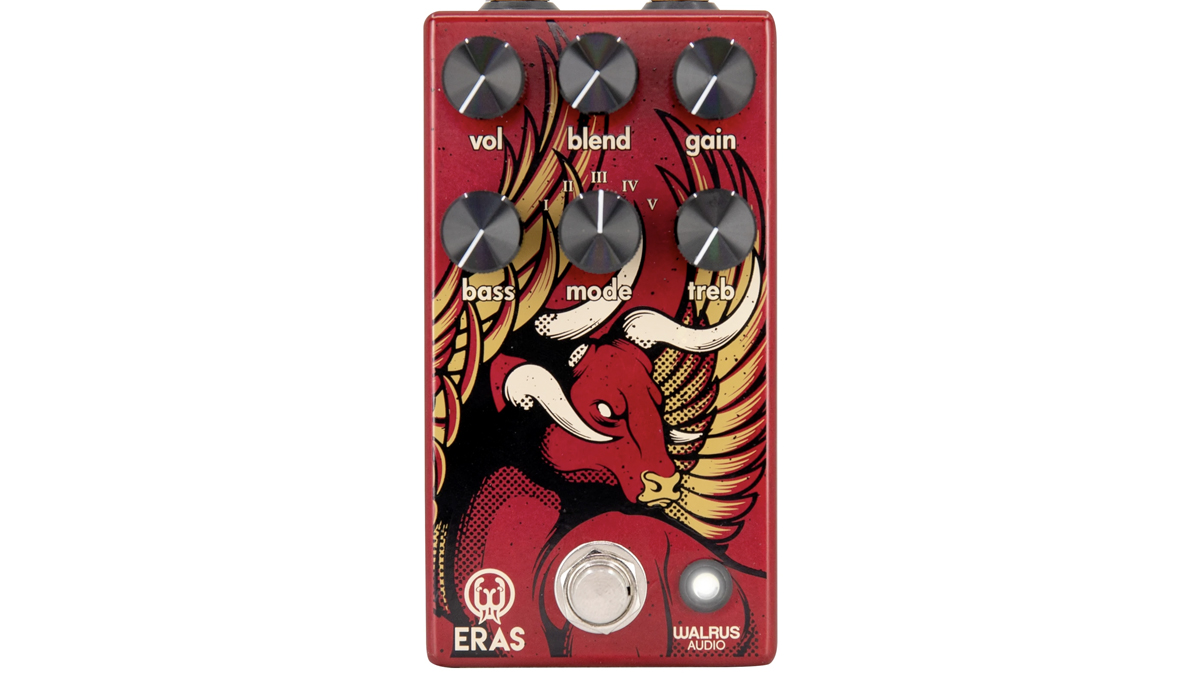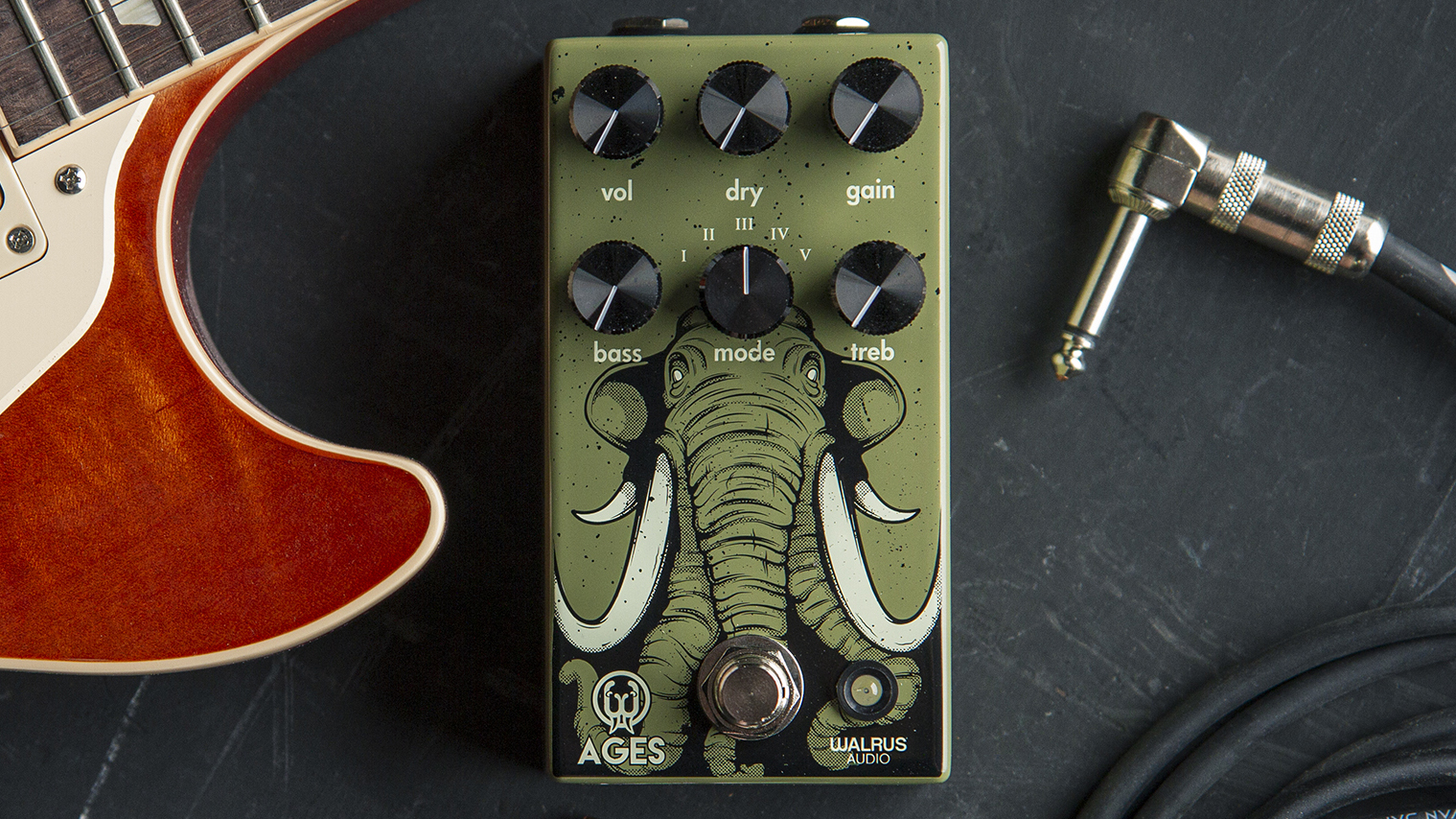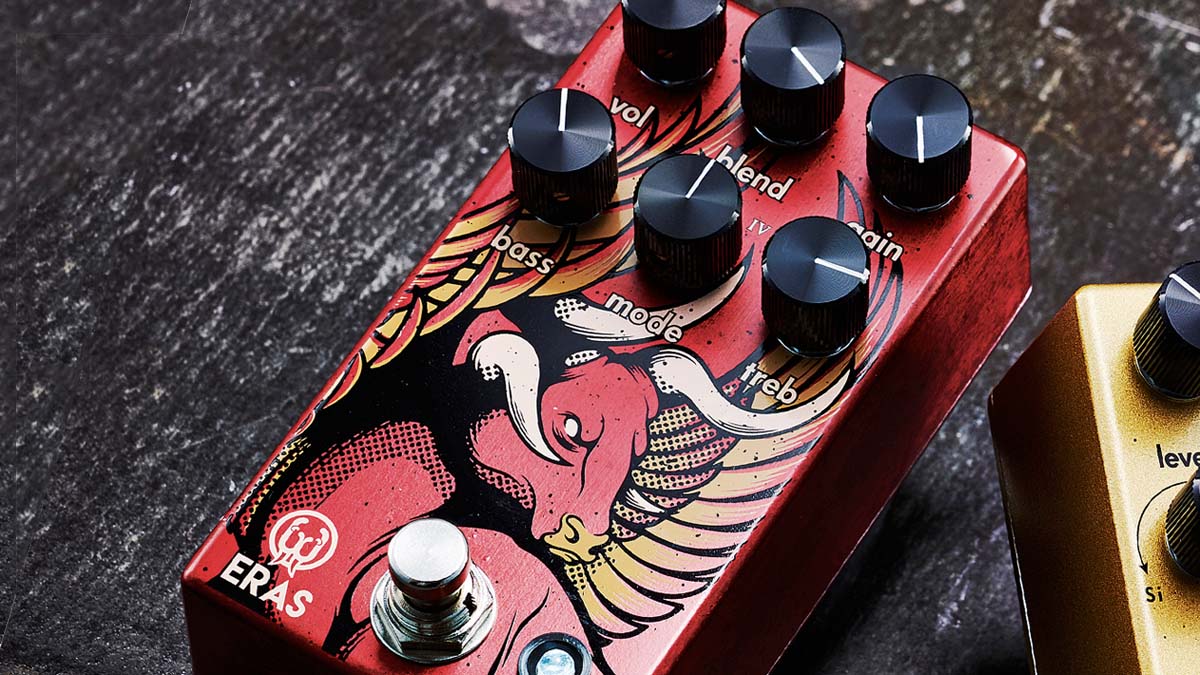MusicRadar Verdict
The Eras does for high-gain distortion what the Ages does for overdrive, presenting up a huge range of practical and inspiring tones via five modes, with the capacity to blend distorted and clean signals making it play nice with others.
Pros
- +
A versatile fire-breather.
- +
Blend knob makes it very useable.
- +
Built to last.
Cons
- -
Not much, but if it is too hot, the Ages overdrive might be more your speed.
MusicRadar's got your back
Walrus Eras Five-State Distortion: What is it?
Designed and built in the USA, the Eras Five-State Distortion from Walrus Audio is one of those rare distortion pedals that is designed for all weathers – though as the enclosure art from Adam Forster might suggest, it skews kinda wild.
If you’re familiar with Walrus’ superlative Ages Five-State overdrive pedal, you’ll be aware of the concept, and can well imagine the amount of tweakability on offer. Eras, Ages… Both have five modes selectable via rotary dial that make these do the work of two or three drive pedals.
That said, Walrus position the Eras as a “no apologies, high-gain distortion”, so while there are five different flavours of distortion via the selectable clipping options, they are going to be voiced to take the paint off the wall.

Of course, high-gain distortion is a moveable feast in itself, and here you can switch between position 1’s LED hard clipping, voiced to keep your palm-muted Hetfield downstrokes super tight, and position 2’s tight mode with silicon hard clipping. Both have a slight mid-cut, referencing the preferences in late ‘80s and early ‘90s heavy metal electric guitar tone.The difference? The latter is smoother, with more compression.
Position 3, meanwhile, is a dual-clipping mode, again with a little bit of a mid-cut but Walrus describes it as “rich and full, with added sustain,” perhaps one mode that identifies itself as a candidate for lead guitar. Finally, Positions 4 and 5 offer a deeper cut to the mids, what Walrus call a rhythm mode with position 4 offering LED clipping and position 5 silicon.
Other controls include Volume, Gain, Bass and Treble, which should be self-explanatory to anyone who has used a distortion pedal and/or a guitar amp, with the Eras’ ace-in-the-hole a Blend control that allows you to adjust the mix of dry signal to suit your needs, which comes in very handy when it comes to stacking the Eras with other drive pedals and fine-tuning your sound.
Walrus Eras Five-State Distortion: Performance and verdict
As we’ve come to expect from Walrus, the Eras’ build is typically tip-top. Running on a standard 9V DC power supply, the jacks are mounted on the top of the unit, which might make life easier when it comes to making room for it on your pedalboard.
Want all the hottest music and gear news, reviews, deals, features and more, direct to your inbox? Sign up here.

• Walrus Audio Ages Five-State Overdrive
A space-saver with an epic range of drive tones, the Ages is a super-practical pedalboard option that can be used for clean, transparent boost, or run it as a de facto cranked stack with hot, saturated gain, and all stages between.
• Mesa/Boogie Throttle Box EQ
With a saturated, yet responsive chunk, the hi mode puts Foo Fighters, Metallica and Dream Theater at your feet, thanks to the extra EQ, which sparkles and scoops without any harshness.
• Wampler Sovereign Distortion
The Sovereign distortion pedal covers an array of dirts and distortions, with options for advanced gain and brighter modes.
Running through the modes, there’s already a great range of distorted tones to play with. Hard rock and metal players will have little difficulty in dialling in a sound that references various stages of metal tone’s evolution. Huge, thick rhythm tones can truly weaponise an open chord, while those tighter settings work a treat when playing kinetic, aggressive riffs.
The EQ can boost or cut frequencies so noon on both Bass and Treble is a good place to start experimenting, and also to find the right EQ solution for the amount of distortion you have in your signal. For instance, high-gain sounds might need a little more treble to slice through a mix or to put more detail into your playing, while lower-gain settings might encourage you to back it off and warm things up.
The Bass knob is interactive with the Gain control, and boosts or cuts low-end after the clipping stage, and there’s plenty of control to adjust to almost any setup. Players using extended range 7 and 8-string guitars will especially appreciate the capacity to tighten up that low end.
Bringing the Blend control online opens up all kinds of possibilities for layering, and especially for adjusting to preserve note clarity when stacking. Impressive.
MusicRadar Verdict: The Eras does for high-gain distortion what the Ages does for overdrive, presenting up a huge range of practical and inspiring tones via five modes, with the capacity to blend distorted and clean signals making it play nice with others.
Walrus Eras Five-State Distortion: The web says
“Overall, there’s plenty here that’s ideal for chuggy rhythms and sustain-y leads. The silicon options sound a little smoother with more compression than the LED, but there’s also the cool complexity of the best-of-both-worlds Tight dual mode where both silicon and LED are in play.”
Guitarist
“The differences between the first three modes are surprisingly subtle, thickening things up as we go around rather than radically transforming the nature of the distortion, but there’s a more noticeable shift when you flip over to the two scooped settings. It isn’t an exaggerated midrange cut – this is not a Metal Muff – but it’s enough to make solos sit in a very different space.”
Guitar
Walrus Eras Five-State Distortion: Hands-on demos
Walrus Audio
Rabea Massaad
Reverb
Mike Hermans
Riffs, Beards and Gear
Walrus Eras Five-State Distortion: Specifications
- ORIGIN: USA
- TYPE: Distortion pedal
- FEATURES: True bypass
- CONTROLS: Volume, Blend, Gain, Bass, Treble, Mode switch, Bypass footswitch
- CONNECTIONS: Standard input, standard output
- POWER: 9V DC adaptor (not supplied)
- DIMENSIONS: 67 (w) x 125 (d) x 57mm (h)
- CONTACT: Walrus Audio
MusicRadar is the number one website for music-makers of all kinds, be they guitarists, drummers, keyboard players, DJs or producers...
- GEAR: We help musicians find the best gear with top-ranking gear round-ups and high-quality, authoritative reviews by a wide team of highly experienced experts.
- TIPS: We also provide tuition, from bite-sized tips to advanced work-outs and guidance from recognised musicians and stars.
- STARS: We talk to musicians and stars about their creative processes, and the nuts and bolts of their gear and technique. We give fans an insight into the craft of music-making that no other music website can.

